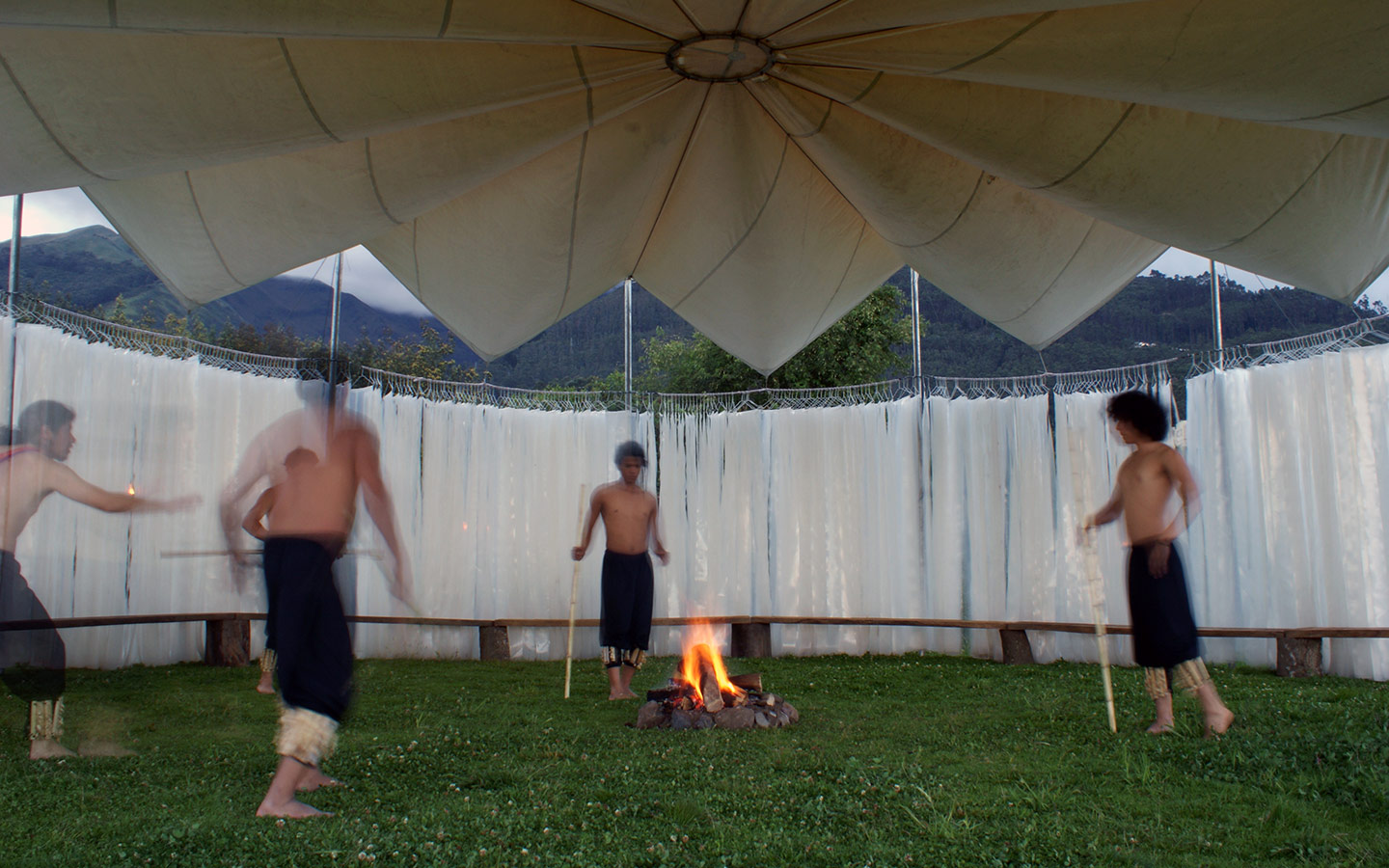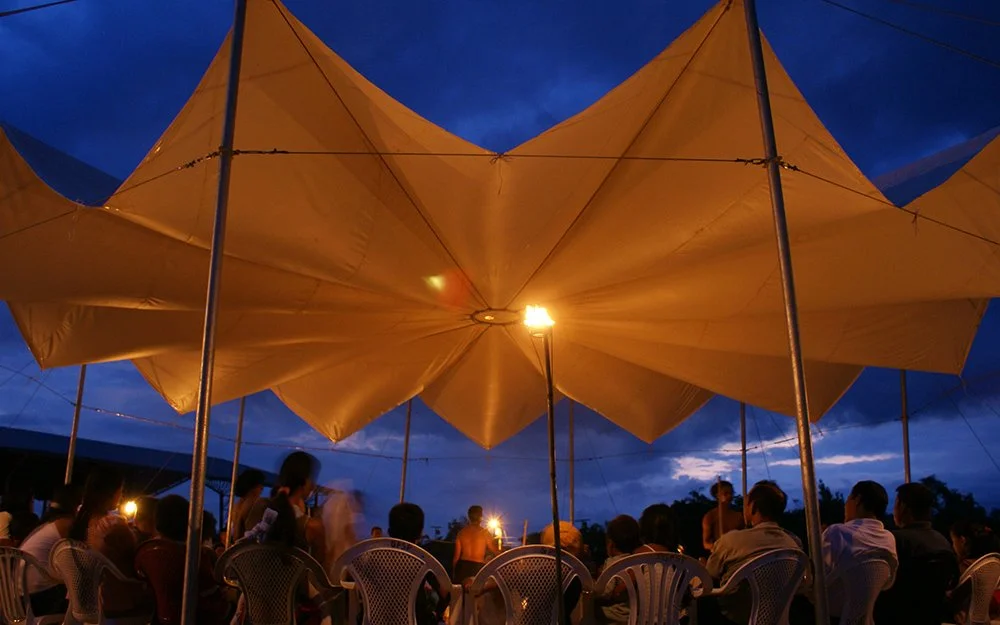Espacio de Experimentación Teatral
Performative Experimentation Pavilion
-
Arquitectos: Al Borde
Proyecto por encargo de: Cuerpo Silencio: Diego Bolaños & Sisa Salgado
Financiado por: Ministerio de Patrimonio del Ecuador
Constructor: AA Máxima: Hernán Arias & Marcelo Pazmiño
Ubicación: Itinerante, Ecuador
Año: 2010
-
Los clientes tienen interés en hacer una investigación sobre expresión corporal en las culturas indígenas de la Amazonia Ecuatoriana. Con la información que obtengan después de un proceso de inmersión, se desarrollará un taller experimental que buscará el traslado de la cosmovisión indígena amazónica a una expresión que combina teatro, danza y performance.
Tras ganar un fondo concursable del Ministerio de Cultura del Ecuador pueden financiar su investigación, parte de este fondo prevé la construcción de un espacio para desarrollar el taller. Los escasos recursos que disponen y una plataforma rectangular de hormigón en una propiedad rural en Atahualpa donde se llevará a cabo la etapa inicial del proyecto, hace que la solución obvia que le propongan a los clientes sea una estructura de galpón, cubierta con planchas de policarbonato.
Previo al inicio de la investigación de dos meses en la comunidad amazónica de Rukullacta, los investigadores quieren dejar resuelto el espacio en donde realizaran el taller a su regreso. Antes de tomar partido a favor o en contra del galpón sugerido, decidimos conversar con los investigadores sobre el alcance del proyecto y entendemos que en ese momento no hay un proyecto certero, solo saben que después de su inmersión descubrirán hacia dónde va el trabajo con los talleristas e incluso en este proceso de trabajo de dos meses no tendrán una conciencia clara de lo que busca, el proyecto lo ven como un proceso en constante construcción más que como una meta final. Esta incertidumbre en la definición clara de las necesidades del espacio se convierte en el motor del proceso de diseño.
Al no tener claro el tipo de investigación a realizarse y sabiendo que el espacio condiciona la actividad nos preocupa que el galpón prejuicie su desarrollo. Las formas ortogonales en planta inevitablemente tienen jerarquías en su uso. El círculo, por otro lado, ayuda a crear un ambiente neutro, sin jerarquías, donde el movimiento está condicionado lo menos posible por el espacio, beneficiando la experimentación.
Dentro del proyecto estaban previstas tres etapas en diferentes lugares: La investigación en Rukullacta, el desarrollo del taller en Atahualpa, y presentaciones de los resultados en distintas locaciones del país. La última variable de diseño surge sola, el espacio debía ser transportable, aprovechando así los escasos recursos y multiplicando su funcionalidad, el espacio de trabajo se transforma en espacio de presentaciones.
Respondiendo a la necesidad de transporte y fácil montaje, el diseño busca reducir los elementos rígidos a su mínima expresión. Un sistema a tensión con doce pilotes estructura el proyecto.
Influenciado por el teatro pobre de Lerzy Grotowski la propuesta tiende a minimizar los elementos adicionales con los que trabajan los investigadores, por lo que entendemos que el límite horizontal no tiene que ser transgredido, basta con una altura suficiente para trabajar, que actúe como difusor de la luz del sol y que sea de fácil transporte y montaje.
Por el contrario el límite vertical, debe maximizar la versatilidad del espacio y evitar prejuiciar la investigación. Se crea un límite difuso, austero y neutro como una barrera penetrable que pueda aislar - integrar el entorno dependiendo de los requerimientos. Cuando comienza el trabajo en sitio se descubre la necesidad que el espacio no sea envuelto en la totalidad de su perímetro, estar abierto al este es necesario, el sol es importante dentro del proceso. La flexibilidad del proyecto permite responder a este planteamiento sin por eso alterarlo.
El trabajar clientes y diseñadores sin prejuicios, permitió un acercamiento libre al proyecto, abrió las posibilidades que el espacio brindaba y aportó al todo, de manera que el espacio arquitectónico es incluido dentro de la propuesta metodológica como una variable importante dentro del proceso de investigación.
-
2013, Espacio de Experimentación Teatral / Tectónica / Borja López Cotelo
2013, Espacio de Experimentación Teatral / Freshlatino02
2012, ARQ 81 - Espacios para la Cultura / Ediciones ARQ
2012, Espacio de Experimentación Teatral / Scielo
2011, Performative Exploration Pavilion / C3 Magazine 324
2011, Espacio de Experimentación Teatral/ Archdaily
-
Architects: Al Borde
Project commisioned by: Cuerpo Silencio: Diego Bolaños & Sisa Salgado
Funded by: Ministry of Heritage of Ecuador
Construction: AA Máxima, Hernán Arias & Marcelo Pazmiño
Location: Itinerant, Ecuador
Year: 2010
-
Clients are interested in doing a research about elements of the ancestral tradition of Kichwa de Rukullakta town in Ecuadorian Amazon. The information obtained from the research, will support an action research process that seeks the transfer of Amazonian world view to expressions applied to theater, dance and performance.
After winning a grant fund of the Ecuador´s Ministry of Culture, clients can support his research. The initial phase of the workshop will be developed in the client´s rural property at Atahualpa. The limited resources available and a rectangular concrete platform at the property, makes a warehouse structure covered with polycarbonate sheets, the client´s first choice.
Before starting the two months investigation in Rukullacta Amazon community, researchers want the workshop space solved, where the process of practical investigation will be done, in his return. Instead of taking sides for or against the suggested option, we decided to talk to the researchers about the scope of the project, especially of the mentioned space, and we understand that at the time they hasn’t joined the necessary elements for this to be determined, clients just know that after the immersion in the community, they will have information to work with at the workshop. Even in the workshop process clients think they will not have a clear awareness of what they´ll need. Researches see the project as a constant building process rather than a final goal. This uncertainty clearly defines the needs of the space and becomes the engine of the design process.
The undefined kind of research to be done in the practical process might increase the influence of the space into the activity; we were concerned that the shed might prejudge the workshop development. The platform floor plan forms orthogonal hierarchies to the user. The circle, on the other hand, helps to create a neutral environment, without hierarchies, where the movement is influenced as little as possible, which benefits the experimentation.
Within the project were provided three stages in different places: The Rukullacta research, the practical process development in Atahualpa, and the presentations of the results at different locations around the country. We find the final design variable, the space should be transportable, thus making use of scarce resources and multiply their functionality, the workspace will become the performance space.
Answering to the need for transportation and easy assembly, the design seeks to reduce the frame elements to the minimum. A twelve piles tension system structures the space.
Influenced by Jerzy Grotowski’s poor theatre, the proposal tends to minimize the additional elements the researchers work with, so we understand that the horizontal limit must not be transgressed, just high enough to work. It should be easy to transport, easy to setup and work as sunlight diffuser.
On the contrary, vertical limit should maximize the versatility of the space and avoid prejudge the investigation. It creates a blurred line, austere and neutral as a penetrable barrier to insulate-integrate the environment depending on requirements. When the work on site started, is discovered that it needs an open side. The flexibility of the project can respond to this approach without altering it.
Clients and designers working without bias allowed a free approach to the project, opened the possibilities and provided to the whole. The architectural space is included within the proposed methodology as an important variable in the research process.
-
2013, Espacio de Experimentación Teatral / Tectónica / Borja López Cotelo
2013, Espacio de Experimentación Teatral / Freshlatino02
2012, ARQ 81 - Espacios para la Cultura / Ediciones ARQ
2012, Espacio de Experimentación Teatral / Scielo
2011, Performative Exploration Pavilion / C3 Magazine 324
2011, Espacio de Experimentación Teatral/ Archdaily


















